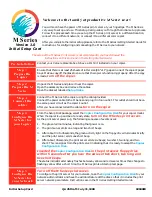
14-11
Cisco SCE 8000 10GBE Software Configuration Guide
OL-30621-02
Chapter 14 Value-Added Services (VAS) Traffic Forwarding
VAS Redundancy
When the Cisco SCE platform detects that the number of active servers within a group is below the
configured minimum, it changes the state of the group to
Failure
. The configured action-on-failure is
then applied to all new flows mapped for that VAS server group (existing flows are not affected.)
There are two possible actions when the VAS server group has failed:
•
Block
—All new flows assigned to the failed VAS server group are blocked by the Cisco SCE
platform.
•
Pass
—All new flows assigned to the failed VAS server group are considered as regular non-VAS
flows, and are processed without VAS service (that is, they receive SCA BB service but not VAS
service).
When the number of active servers is above the minimum and the state of the group is changed to Active
again, the configured action-on-failure is no longer applied to the new flows. However, to maintain the
coherency of the network, flows that were blocked or passed are not affected by the change in the state
of the server group.
Ethernet Switch Failure
The Ethernet switches are a single point of failure in a VAS topology. A complete failure of an Ethernet
switch causes all the VAS services to be declared as failed and the configured action (on-failure) is taken
for all new VAS flows.
Disabling a VAS Server
A VAS server can be disabled for maintenance via the CLI.
No errors are reported on a disabled VAS server. However, if disabling the server reduces the number of
active servers to below the minimum number configured for the group, it brings down the VAS server
group because a disabled VAS server is equal to a VAS server in
Down
state.
Health check is not performed on disabled VAS servers.
















































